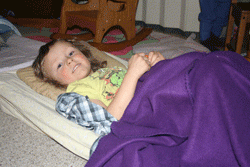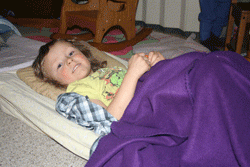For young children, it is good to have very clear routines and rituals around sleep. It helps to think about what you are doing for the two hours before sleep, what you will do to prepare them for sleep, and what you will do when they first wake up. I call this “framing” sleep. The routines and rituals provide the frame.
Here is an example of a sleep frame:
An hour or two before nap, the children are outside playing. It is important that they have a full experience of the natural world and can play as freely as possible. When you bring them in, perhaps a special song or game gathers everyone together, and you playfully return inside.
Everyone takes off their shoes and outdoor garments and places them nicely where they belong. It is wise to ask them to go back and rearrange them (or help them to do this) if they have left them in disarray. This educates their will and supports a sense of order in the environment. In planning your time with children, allowing sufficient time for these types of domestic activity needs to be considered.
A container of warm lavender water is waiting for them. Each child receives a gentle foot bath. Then their feet are dried and a soft cream is rubbed in.
Now it is time to wash hands to prepare to eat. Some of the children may help to set the table, while others pour the water to drink. A blessing is sung; perhaps a candle has been lit. One or two short finger games may be played. Then the food is served family-style, and everyone eats.
After eating, the children help to wash their dishes. Now it is time for toileting. Then each child is given a warm face cloth to wash faces and hands.
Perhaps a story is told as they gather around their caregiver. Or perhaps the story is told after they are laying down.
It is important that they rest in the same place each time. This becomes their special spot. Fresh air in the room is important – even a slightly open window. If it is too noisy outside, then air out the room for quite some time before the children come in to sleep. It can be quite nice to warm the bed with a hot water bottle before they lay down. If possible, a sheepskin on the cot or bed is also nice to lie on. Each child may have a special blanket from home to sleep under, and if they have a special cuddly doll, they can sleep with that.
When they are lying down, the teacher or caregiver goes to each child and gently strokes faces or hands with light fingertips. This is very soothing for most children. If there is a child who really does not like it, then it should not be done to that child. Perhaps instead a gentle pat on the shoulder, or a little foot rub will be accepted.
After each child has been gently touched, then can come some quiet singing or humming (or a story if it was not told earlier) or strumming a gentle instrument like a kinderharp. Eventually everything is quiet, and the caregiver may just sit in a rocker and slowly rock or just sit still and rest herself.
What makes a difference is if the caregiver can truly feel restful herself. This helps the children to go to sleep. If the caregiver is busy thinking of many other things or is restless, it will be more difficult for the children to feel restful.
It is a good time for the teacher or caregiver to take a very brief moment to let her thoughts rest on each child. Picture the child in a moment during the day when he or she seemed to be most balanced and hold that picture in your heart. If you find yourself instead picturing a difficulty you are having with a child, then try to see the behavior objectively and with interest and warmth. Taking the time to briefly picture each child strengthens your partnership with the child’s angel who is always interested in connecting to those who care for the child.
 Some older children may not fall asleep, although I find that most children do fall asleep. It is nice if the children can sleep at least one hour, and if they are younger, then perhaps 1.5 hours, but not usually more than two. Ideally the children would be able to go to bed at night by 7:00 p.m., and this is difficult if they have slept too long in the day.
Some older children may not fall asleep, although I find that most children do fall asleep. It is nice if the children can sleep at least one hour, and if they are younger, then perhaps 1.5 hours, but not usually more than two. Ideally the children would be able to go to bed at night by 7:00 p.m., and this is difficult if they have slept too long in the day.
When the children begin to wake up, they may need to go to the bathroom. They should also be encouraged to have a full glass of water. Then, it is a nice time to brush each child’s hair and put a refreshing oil on their faces. It is like a new beginning to the remainder of the day. .
If it is allowed, older children could go outside while they wait for the others to wake. Otherwise, they can draw or be given quiet things to play or ongoing projects to work on, like sewing or finger knitting or looking at a beautiful book.
After all the children are awake, hair brushed, and faces oiled, it is time for a simple snack. Then cleaning up and going back outside until time to go home.
The important thing to remember is that sleep is a time for restoring themselves and for their angels, our silent partners, to quietly watch over them. Nap time is one of the most sacred times of the day in our work with little ones. This is why we want to bring so much consciousness to how we do it.
Cynthia Aldinger is the founder and director of LifeWays North America and lives with her husband in Norman, Oklahoma.
